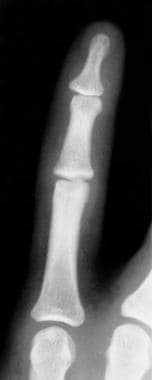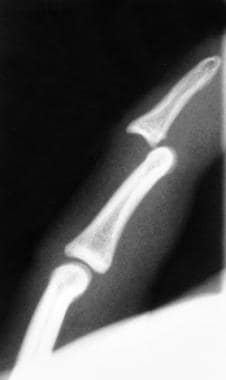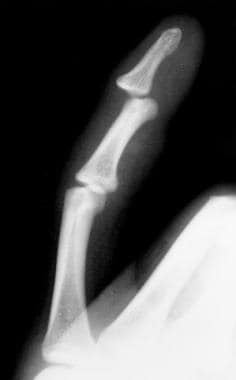Practice Essentials
Interphalangeal (IP) joint dislocations of the fingers and toes are common. [1, 2, 3] Typically associated with forced hyperextension or hyperflexion of the digit, they require immediate reduction.
Diagnosis
Take anteroposterior, true lateral, and oblique radiographs of the affected digit. Obtain three views prior to and after reduction.
See the images below.
Treatment
Splint, ice, and elevate the affected digit. [4] Neurovascular status should be evaluated before and after transport to the emergency department (ED). Administer digital block anesthesia 10-15 minutes before any reduction maneuver. Be sure to remove all rings.
With the patient's hand or foot securely braced, grasp the dislocated phalanx with dry gauze loosely wrapped around the phalanx, and hyperextend the joint slightly with gentle longitudinal traction for a dorsal dislocation or hyperflex for a volar dislocation. Gradually push the dislocated phalanx into its normal anatomic position. [4]
Do not apply vigorous traction in a child, because that may interpose soft tissue or an osteochondral fragment into the distracted joint space and prevent reduction.
After reduction, examine the affected joint for flexor-extensor tendon function, active range of motion, localized tenderness, and instability in the medial-lateral and dorsal-volar directions. Immobilize the joint with a foam-padded splint immediately after reduction to prevent redislocation or instability.
Pathophysiology
The IP joint is a hinge joint that allows only flexion and extension and consists of several ligamentous complexes. The volar plate provides stability against hyperextension injury and dorsal dislocation of the phalanx. It often ruptures during a dorsal dislocation and may be associated with an avulsion fracture at the base of the phalanx. The strong collateral ligament complex resists hyperextension and lateral dislocation injury. The extensor hood complex stabilizes against hyperflexion injury and volar displacement of the phalanx.
Dislocations of the distal interphalangeal (DIP) joint of the fingers are often associated with fracture, tendon rupture, and/or proximal interphalangeal (PIP) joint involvement. Upon axial loading and hyperextension of the fingertip, the volar plate of the DIP joint tears and the joint may be displaced. [5, 6, 7, 8] Forced hyperflexion results in a volar IP joint dislocation (eg, where the distal phalanx is dislocated volar to the middle phalanx). [9]
According to studies, 59.4% of all dislocations involve the joints of the thumb or little finger, with the highest dislocation rates being in the PIP joint of the little finger, the metacarpophalangeal joint of the thumb, and the PIP joint of the ring finger. Although dislocations of both the PIP joint and the DIP joint in the same finger are rare, they do occur. [10, 11] The little finger is most likely to be affected. [12]
Dislocations are relatively uncommon in children. Lateral bending forces are more often transmitted through the physis rather than the collateral ligaments in a child‘s hand because the growth plate is the path of least resistance. Although rare, the thumb metacarpophalangeal (MCP) joint is the most commonly dislocated joint in the skeletally immature hand. The PIP joint is the most commonly injured articular surface, involving volar plate or collateral ligament avulsion fractures.
Causes of interphalangeal dislocations include axial compression or lateral forces directed to the digit; forced hyperextension or hyperflexion of the digit from traumatic athletic injury, entrapment of finger between objects, or a fall; and predisposition to ligamentous injury in those with lax ligaments (eg, Down syndrome).
Epidemiology
A study of patients who presented to US emergency departments with finger dislocations showed that most of these injuries occur in persons aged between 15 and 19 years. Nearly 79% of patients with finger dislocations are male. About 46% of dislocations occur in Whites, 18.5% in Blacks, and 8.5% in Asian or Hispanic persons. Most of the injuries (69.9%) result from sports or recreational activities, typically basketball or football. [13]
Prognosis
Complications
Complications are rare with early reduction, although persistent pain or swelling is common. Despite appropriate management with rest, ice, and elevation, pain and swelling may persist for 6-12 months. [4]
Inadequate immobilization after reduction may result in redislocation.
Prolonged immobilization may result in muscle contracture.
Volar plate injury may lead to recurrent dislocation with chronic laxity, hyperextensibility (swan-neck deformity on active extension), or flexion contracture (pseudoboutonnière deformity without DIP hyperextension).
Late or delayed reduction commonly results in loss of joint motion, joint instability, and limitation of hand function.
PIP joint injuries often cause complications, such as ankylosis, joint instability, post-traumatic arthritis, and flexion contracture. [14, 15]
Complications of DIP joint injuries include extensor or flexor tendon rupture, swan neck deformity, chronic hyperesthesia or edema, and recurrent instability. [16]
-
Anteroposterior view of distal interphalangeal (DIP) joint dislocation
-
Lateral view of distal interphalangeal (DIP) joint dislocation
-
Oblique view of distal interphalangeal (DIP) joint dislocation
-
Oblique view of proximal interphalangeal (PIP) joint dislocation





